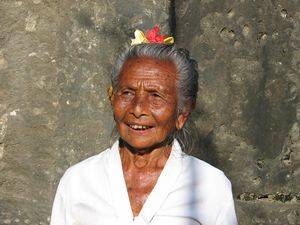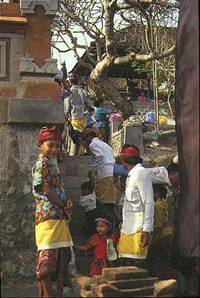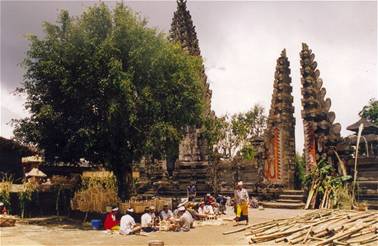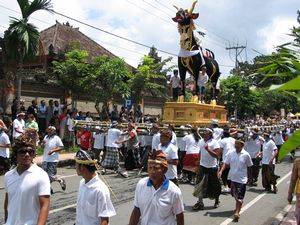
Ethnic and cultural
It is not easy to differentiate between Hindu Religion and custom or culture of Bali.
The majority of the people of Bali embrace Hindu Dharma religion. Ancient belief on nature spirits such as spirit of waters, mountains, trees etc. may be originated in prehistoric period of Balinese people ancestors.
The Balinese only have four first names. The first child is Wayan or Putu, the second child is Made or Kadek, the third is Nyoman or Komang and the fourth is Ketut. The fifth, sixth, seventh, eighth and ninth will be another Wayan, Made, Nyoman, Ketut and Wayan again.
Each stage of Balinese life is marked by a series of ceremonies and rituals known as Manusa Yadnya. They contribute to the rich, varied and active life the average Balinese leads. Balinese are mostly Hindus but Balinese Hinduism is a world away from that of India. At one time Hinduism was the predominant religion in Indonesia (witness the many great Hindu monuments in Java) but it died out with the spread of Islam through the archipelago. The final great Hindu Kingdom, that of the Majapahits, virtually evacuated to Bali, taking not only their religion and its rituals but also their art, literature, music and culture.

In practicing their faith, Hindu communities try to achieve a spiritual balance of worship between Tattwa (philosophy), Susila (morals), and Upacara (rituals). These three areas are subdivided into various tenets. In Bali, the high priest, selected from the Brahman caste, officiates at large ceremonies. The village temple priest, who may be from any caste, looks after the temple and leads certain holy rituals included in the Panca Yadnya. The holy books of the Hindu religion are the Vedas, which originate in India. Those which reached Bali are the Catur and the Veda Cirah, which are still used by priests in carrying out their religious duties. The religion is taught in other forms as well. The most popular of these are the Purana, or morality plays, and the Itihasa, or epic poems, such as the Ramayana and Mahabarata epics. Shadow puppet plays, operas, ballets, and other forms of drama are also vehicles of religious teaching in Bali.

Cremation of the dead is perhaps the most important -- and often the most colorful -- ritual of Balinese Hinduism. A cremation is necessary to liberate the soul of the deceased for the passage into heaven and reincarnation. Due to the cost and the complicated preparations, cremations often occur long after the death of the person. Group cremations are sometimes held in order to share the expenses. Between death and cremation the body is buried in the cemetery. During this time, the soul of the deceased is thought to be agitated and longing for release.

The strong cultural identity of Bali is based on a combination of closely related elements that include its unique religion, its language, its castes, its community life, and its art. Bali is famous for the arts, both the performing arts as well as painting, sculpture, and woodcarving. Balinese gamelan music is highly developed and varied. Famous Balinese dances include Pendet, legong, baris (dance), topeng, barong, Kecak (the fire dance) and many others. The dances portray stories from Hindu Epics such as Ramayana.
Numerous ceremonies mark the progression of life in Bali, starting, of course, with birth. Children are treated with respect and gentleness; corporal punishment is rare. In adulthood, marriage becomes compulsory and represents the individual's official entry into the community as an adult. Subsequently, participation in the meetings of the Banjar (village association that manages village affairs) becomes obligatory.
The management of the all-important water supply falls under another essential community organization called the Subak, to which each village landowner belongs. Bali's irrigation system, unique in the world, is managed by these associations, which ensure the fair distribution of water and carry out the traditional ceremonial rites to the gods of agriculture.

The Balinese also use two local calendars, the Hindu saka and the wuku. The Balinese year has 210 days. The two most significant events are Galungan and Nyepi.
The Galungan Festival, Bali's major feast, is held throughout the island and is an annual event in the wuku year. During this 10-day period all the gods come down to earth for the festivities and barongs (mythical lion-dog creatures) prance from temple to temple and village to village. The last and most important day of the festival is Kuningan.
Nyepi is the major festival of the saka year - it's the last day of the year, and usually falls towards the end of March or the beginning of April. The day before is set aside as a day of purification across the island. The night before, evil spirits are noisily chased away with cymbals, gongs, drums and flaming torches. On Nyepi itself, everyone stays quietly at home, making no noise, using no lights and doing no cooking. The idea is that when evil spirits descend, they are fooled into thinking that Bali is uninhabited and leave the island in peace for another year. |